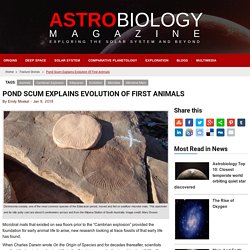

Astrobiology Magazine is a NASA-sponsored online popular science magazine. Our stories profile the latest and most exciting news across the wide and interdisciplinary field of astrobiology — the study of life in the universe.
Can life be shared between planets in close proximity? Rocky? Habitable? Sizing up a Galaxy of Planets. Was life on the early Earth purple? NASA Should Expand the Search for Life in the Universe and Make Astrobiology an Integral Part of its Missions, Says New Report. Gravity Assist Podcast: Planetary Defense with Kelly Fast. Planets. Outer solar system facts program, solar system planets information.
NASA. Extraterrestrial life. Geology and Earth Science: Facts, Updated News, Videos, Images. Sun Solar System: news, facts, photos on Sun planet solar wind, sunspots. Scientists 'fix' bacterial tree of life. Saturn Planet News, Atmosphere Surface, Rings, Cassini Mission, Moons. Venus Solar System Exploration: Latest News, Photos of Venus Planet. New Planets: Exoplanet Latest News, New Planets Videos and Photos. Jupiter Planet News. Earth Magnetic field. MARS DUST STORM WITH MELINDA KAHRE: GRAVITY ASSIST PODCAST. Alien Life News. Gravity Assist Podcast: Exploring Mars, with Steve Squyres. Complex organic molecules discovered in Enceladus’ plumes could hint at life. Clues to recovery from mass extinction. Mars Curiosity Celebrates Sol 2,000. Gravity Assist Podcast: Explorer 1 and Jim Green’s ‘Gravity Assist’ 'Oumuamua likely came from a binary star system. Mars’ oceans formed early, possibly aided by massive volcanic eruptions. The early ocean known as Arabia (left, blue) would have looked like this when it formed 4 billion years ago on Mars, while the Deuteronilus ocean, about 3.6 billion years old, had a smaller shoreline.

Robert Citron images, UC Berkeley. A new scenario seeking to explain how Mars’ putative oceans came and went over the last 4 billion years implies that the oceans formed several hundred million years earlier and were not as deep as once thought. The proposal by geophysicists at the University of California, Berkeley, links the existence of oceans early in Mars history to the rise of the solar system’s largest volcanic system, Tharsis, and highlights the key role played by global warming in allowing liquid water to exist on Mars.
“Volcanoes may be important in creating the conditions for Mars to be wet,” said Michael Manga, a UC Berkeley professor of earth and planetary science and senior author of a paper appearing in Nature this week and posted online March 19. Following the shorelines. Jupiter's atmospheric beauty is more than skin deep. NASA’s Kepler Spacecraft Nearing the End as Fuel Runs Low. Artist rendition of Kepler Space Telescope.

Credit: NASA Trailing Earth’s orbit at 94 million miles away, the Kepler space telescope has survived many potential knock-outs during its nine years in flight, from mechanical failures to being blasted by cosmic rays. At this rate, the hardy spacecraft may reach its finish line in a manner we will consider a wonderful success. With nary a gas station to be found in deep space, the spacecraft is going to run out of fuel. We expect to reach that moment within several months. In 2013, Kepler’s primary mission ended when a second reaction wheel broke, rendering it unable to hold its gaze steady at the original field of view.
Our current estimates are that Kepler’s tank will run dry within several months – but we’ve been surprised by its performance before! Without a gas gauge, we have been monitoring the spacecraft for warning signs of low fuel— such as a drop in the fuel tank’s pressure and changes in the performance of the thrusters. Yale’s EXPRES instrument ready to find the next Earth analog. Asteroids and comets shower Mars with organics. 15 new planets confirmed around cool dwarf stars. Artist conception of K2-155 d.

Credit: NASA Scientists report the existence of 15 new planets — including one ‘super-Earth’ that could harbor liquid water — orbiting small, cool stars near our solar system. These stars, known as red dwarfs, are of enormous interest for studies of planetary formation and evolution. A research team led by Teruyuki Hirano of Tokyo Institute of Technology’s Department of Earth and Planetary Sciences has validated 15 exoplanets orbiting red dwarf systems. One of the brightest red dwarfs, K2-155 that is around 200 light years away from Earth, has three transiting super-Earths, which are slightly bigger than our own planet.
The findings, published in the form of two papers in The Astronomical Journal, are based on data from NASA Kepler spacecraft’s second mission, K2, and follow-up observations using ground-based telescopes, including the Subaru Telescope in Hawaii and the Nordic Optical Telescope (NOT) in Spain. NASA Juno Findings - Jupiter’s Jet-Streams Are Unearthly. Photosynthesis originated a billion years earlier than we thought, study shows. Chemical sleuthing unravels possible path to forming life's building blocks in space. NASA Finds a Large Amount of Water in an Exoplanet's Atmosphere. New data helps explain recent fluctuations in Earth's magnetic field. The moon formed inside a vaporized Earth synestia - Astrobiology Magazine. Extinct lakes of the American desert west - Astrobiology Magazine. Powerful flare from star Proxima Centauri detected with ALMA - Astrobiology Magazine.
Nearly a Decade After Mars Phoenix Landed, Another Look - Astrobiology Magazine. Mars Orbiter on Precautionary Standby Status - Astrobiology Magazine. A Piece of Mars is Going Home - Astrobiology Magazine. Rohit Bhartia of NASA’s Mars 2020 mission holds a slice of a meteorite scientists have determined came from Mars.

One of two slices will be used for testing a laser instrument for NASA’s Mars 2020 rover while it’s still on Earth; the other slice will go to Mars onboard the rover. Image Credit: NASA/JPL-Caltech A chunk of Mars will soon be returning home. A piece of a meteorite called Sayh al Uhaymir 008 (SaU008) will be carried on board NASA’s Mars 2020 rover mission, now being built at the agency’s Jet Propulsion Laboratory in Pasadena, California. This chunk will serve as target practice for a high-precision laser on the rover’s arm. Mars 2020’s goal is ambitious: collect samples from the Red Planet’s surface that a future mission could potentially return to Earth. That level of precision requires a calibration target to help tweak the laser’s settings.
When it comes to extinction, body size matters - Astrobiology Magazine. When it comes to extinction, body size matters - Astrobiology Magazine. Pond Scum Explains Evolution Of First Animals - Astrobiology Magazine. Dickinsonia costata, one of the most common species of the Ediacaran period, moved and fed on seafloor microbe mats.

This specimen and its silly putty cast are about 6 centimeters across and from the Nilpena Station of South Australia. Image credit: Mary Droser. Microbial mats that existed on sea floors prior to the “Cambrian explosion” provided the foundation for early animal life to arise, new research looking at trace fossils of that early life has found. When Charles Darwin wrote On the Origin of Species and for decades thereafter, scientists ascribed the beginning of animal life to the Cambrian, eventually pinned to about 540 million years ago when trilobites and other multicellular organisms emerged in a relatively short timeframe.
The Super-Earth that Came Home for Dinner - Astrobiology Magazine. Astrobiology Magazine Exploring the Solar System and beyond.